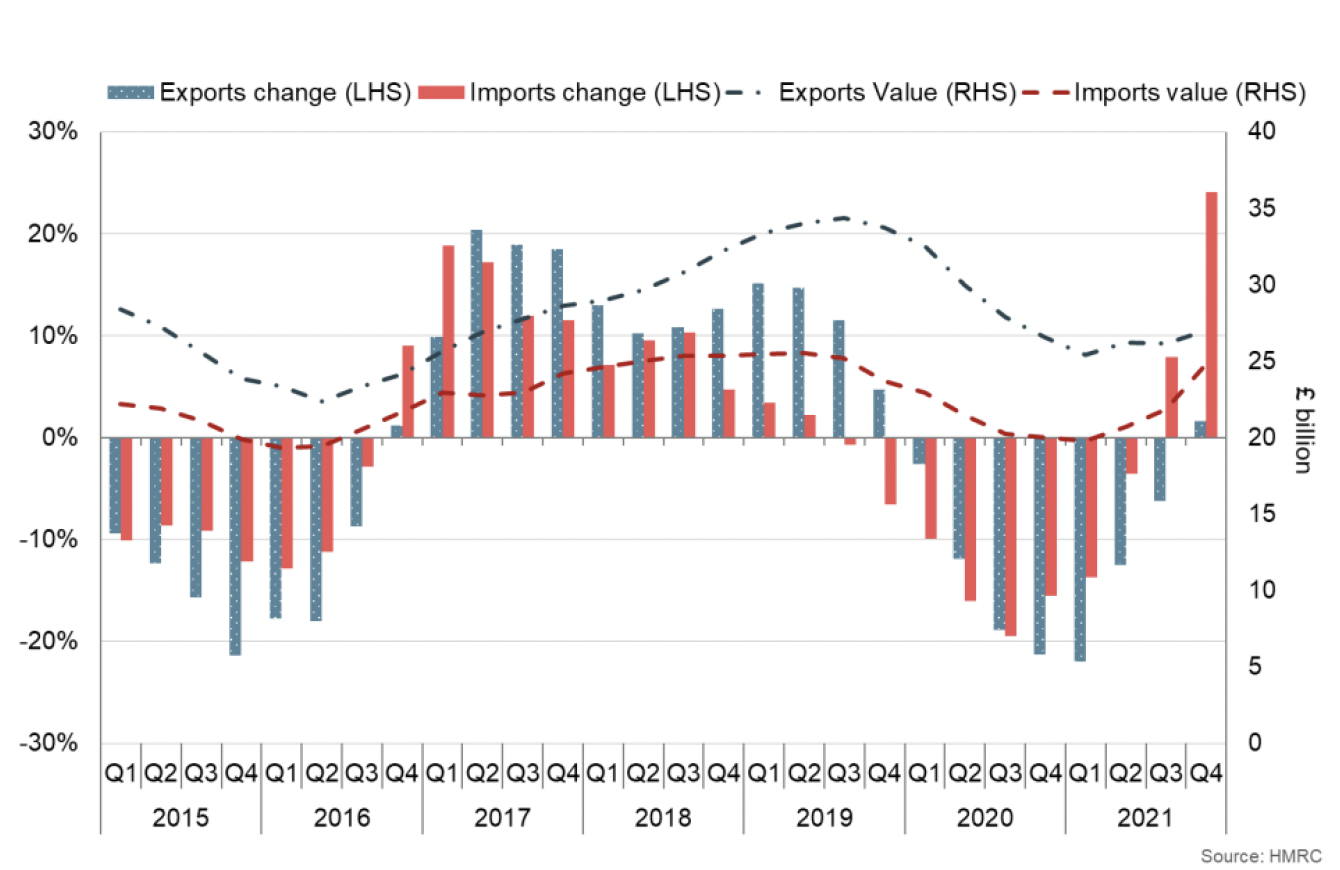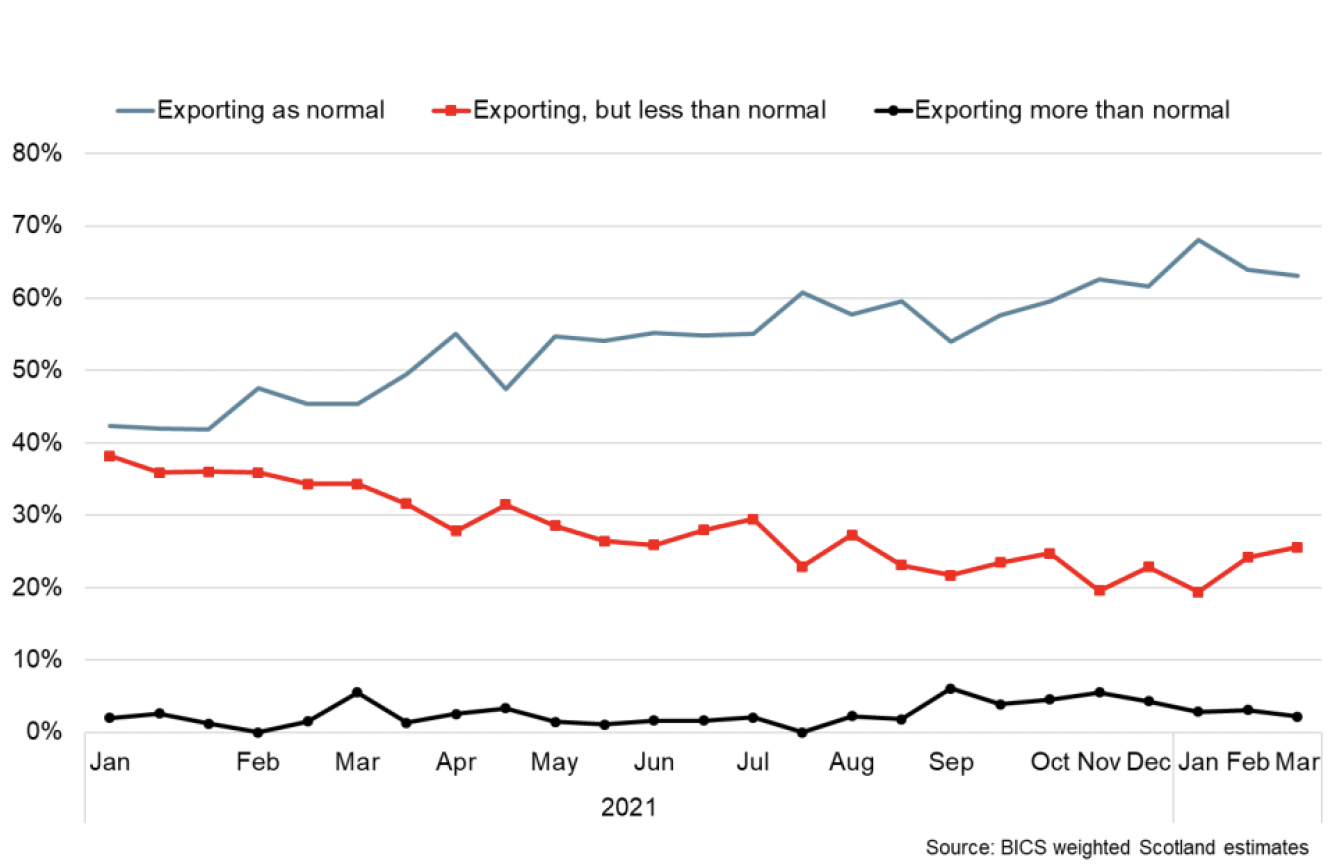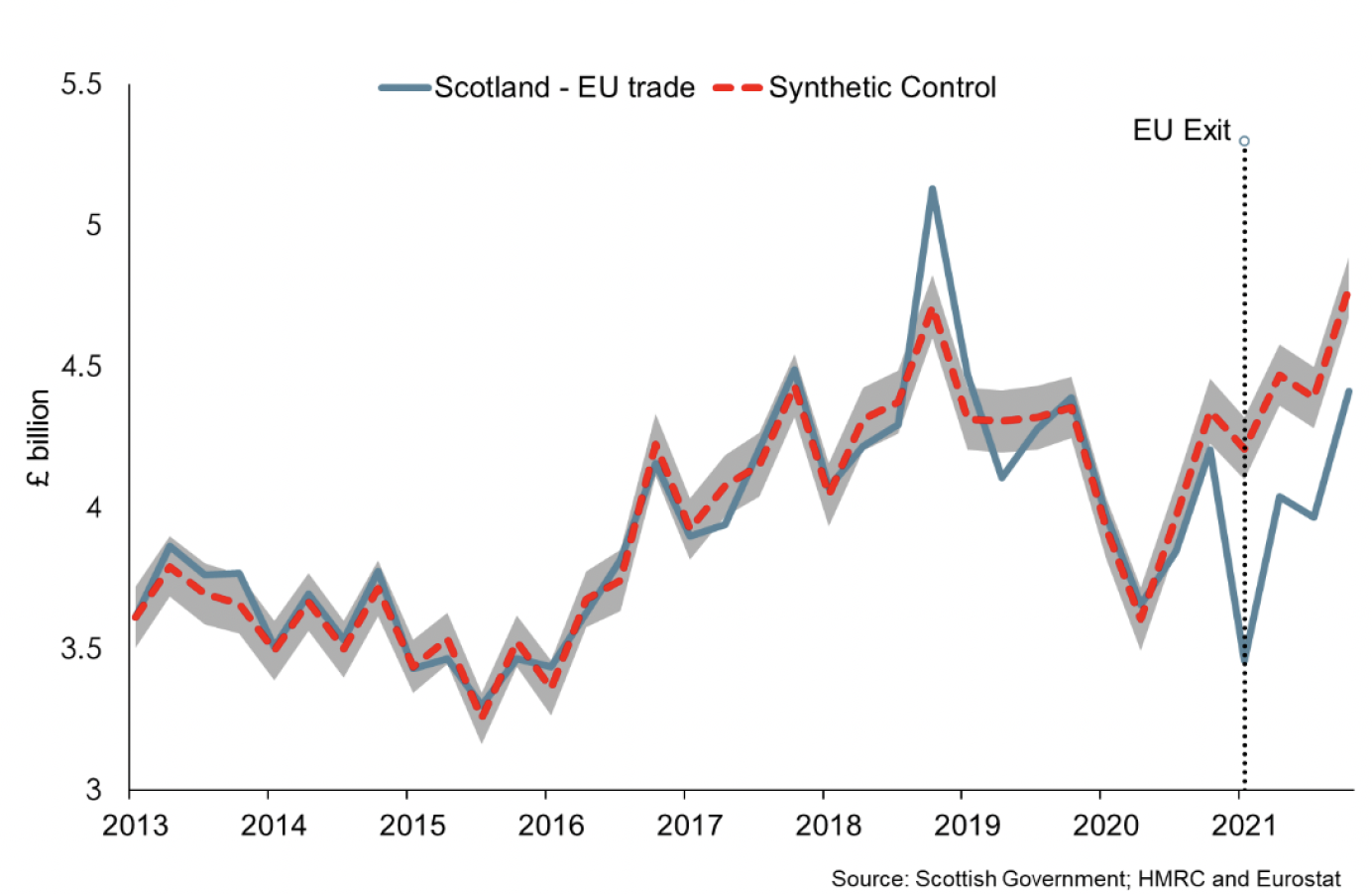State of the economy: May 2022
This report summarises recent developments in the global and Scottish economy and provides an analysis of the performance of, and outlook for, the Scottish economy.
Trade
Scotland's international trade in goods has also experienced significant challenges arising from the impacts of the pandemic and the transition to the new trade agreement between the UK and EU. Trade has, however, shown signs of strengthening over 2021 as the impacts of the pandemic eased.
Compared to 2020, Scotland's goods exports (including oil and gas) increased by 1.6% to £27.0 billion in 2021, although they remained 20% lower compared to 2019 prior to the pandemic. The fall compared to 2019 was driven by a fall in exports of oil and gas which decreased by 46.9% (down £6.5 billion). When this is excluded, Scotland's goods exports fell 1.3% over the period.[15]
Over 2021, exports of chemicals (+22.4%) and manufactured goods (+11.4%) increased notably compared to 2019, however there were decreases in exports of food (-4.8%), beverages (‑6.6%) and machinery and transport (-9.8%).
Compared to 2020, Scotland's goods imports in 2021 (including oil and gas) increased by 24.1% to £24.8 billion and increased by 4.8% compared to 2019 prior to the pandemic. The increased value of imports was driven by oil and gas (+119.2% compared to 2019) and when excluded, international goods imports rose by 1% over the year and fell 10.8% compared to 2019.

More recent business survey data for April indicates trading conditions remain challenging for businesses. 63% of Scottish businesses report to be exporting as normal for the time of year while the share reporting they are exporting less than normal has risen to 26%, up from around 20% at the start of the year. [16]

This is likely to reflect ongoing supply chain disruptions which are expected to be exacerbated by the situation in Ukraine and the recent Covid lockdown restrictions in China. In April, 41% of exporters and 50% of importers reported facing changes in transportation costs (down from 48% and 57% respectively in March) while 26% of exporters and 39% of importers reported facing challenges with custom duties and levies (down from 33 and 40% respectively in March).[17]
How has Scotland's trade in goods with the EU been affected by the new UK-EU trading arrangement?
On 1st of January 2021, trade between the UK and EU became governed by the new trading agreement, the Trade and Cooperation Agreement (TCA). While not introducing tariffs on trade with the EU, this was still expected to increase the cost of trading with the EU for Scottish businesses due to additional checks and reporting requirements.
To quantify the impact of the new relationship on Scotland's trade with the EU, a counterfactual (the synthetic control) is estimated to provide an indication of what would have happened to trade if there had been no change in the trading relationship with the EU. The synthetic control is a weighted average of similar countries which closely track Scotland's trade with the EU before the implementation of the TCA. The divergence between the synthetic control and real Scotland allows an empirical estimate of the TCA impact. The analysis assumes that the impact of the pandemic or other common shocks on trade with the EU is already reflected in the counterfactual. The analysis only covers trade in goods as data on Scotland's trade in services in 2021 is not available. It also excludes trade in oil & gas which are more influenced by overall changes in demand for fuels rather than TCA-related changes. No trade with the rest of the UK or Non-EU partners is included in this analysis.
The estimates show that Scotland's trade in goods with the EU was lower in 2021 than it otherwise would have been under continued EU membership. When the impact on imports and exports are estimated separately, the TCA is found to have a statistically significant effect on imports from the EU, an effect which has persisted in each quarter of 2021. The estimates suggest that imports from the EU in 2021 were 18% to 25% lower than they otherwise would be, equivalent to between £1.7 and £2.5 billion in cash terms. The central estimate suggests that imports have been 22% lower (or £2.1 billion lower in cash terms). Meanwhile the model finds a significant impact of EU Exit on exports to the EU in the first quarter of 2021, when EU exports were 9% to 14% lower than the counterfactual, equivalent to between £200 to £300 million in cash terms. The model finds no significant impact of EU Exit on exports to the EU beyond the first quarter.
The chart below shows that Scotland's trade in goods with the EU has diverged from its counterfactual. This takes into account the shortfall in imports between Q1 and Q4 2021, and the shortfall in exports in Q1 2021. Overall, the central estimate shows that during 2021 trade in goods with the EU was 12% lower (or £2.3 billion in cash terms). The estimated shortfall in trade with the EU ranges from 10% to 14%, or £1.9 billion to £2.7 billion in cash terms. The effect is driven primarily by lower imports from the EU.

These findings are consistent with the research by LSE CEP[18] and UK Trade Policy Observatory[19] that found a small and temporary effect of the TCA on UK exports to the EU and a persistent decline in EU imports. The CEP study also found a sharp drop in the number of varieties/products exported to the EU while exports of high-value products have increased, supporting recovery in aggregate EU exports in 2021.
Robustness checks for imports (the main driver of the overall impact) suggest that the estimated gap is not affected by any specific country included in the comparator. Some differences in estimates are obtained when the policy date is backdated but all estimates follow the same pattern in 2021. Finally, the gap in imports becomes insignificant when some sectors are excluded from the total which may be expected if the TCA has affected some sectors more than others.
Contact
Email: OCEABusiness@gov.scot
There is a problem
Thanks for your feedback